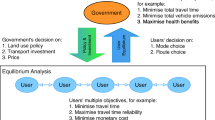Abstract
Two optimization models for residential location in an urban area are presented. In both models the trade-off between the local residential density and the access to workplaces is fundamental. In the first model a social welfare function is considered that can be interpreted as the aggregated expected utility received by the individuals. In the second model the welfare function is expressed in terms of two planning indicators. The models are applied to the Stockholm region in an empirical comparison. In particular, a study is made of how various preferences concerning residential density and travel time affect the optimal housing distribution.
Similar content being viewed by others
References
Broughton, J. and Tanner, J. C. 1983. Distribution models for the journey to work.Environment and Planning A 15: 37–53.
Coelho, J. D. and Williams, H. C. W. L. 1978. On the design of land use plans through locational surplus maximization.Papers of the Regional Science Association 40: 71–85.
Holm, M. and Lundqvist, L. 1977. Spatial allocation of housing programmes: a model of accessibility and space utilization.Papers of the Regional Science Association 38: 149–168.
Karlqvist, A. 1975. Some theoretical aspects of accessibility based location models. InDynamic allocation of urban space, eds. A. Karlqvist, L. Lundqvist and F. Snickars, pp. 71–88. Westmead: Saxon House.
Lundqvist, L. 1978. Urban planning of locational structures with due regard to user behaviour.Environment and Planning A 10: 1413–1429.
Lundqvist, L. and Mattsson, L.-G. 1983. Transportation systems and residential location.European Journal of Operational Research 12: 279–294.
Mattsson, L.-G. 1984. Equivalence between welfare and entropy approaches to residential location.Regional Science and Urban Economics 14: 147–173.
Wilson, A. G., Coelho, J. D., Macgill, S. M. and Williams, H. C. W. L. 1981.Optimization in locational and transport analysis. Chichester: John Wiley.
Author information
Authors and Affiliations
Rights and permissions
About this article
Cite this article
Mattsson, LG. Some applications of welfare maximization approaches to residential location. Papers of the Regional Science Association 55, 103–120 (1984). https://doi.org/10.1007/BF01939847
Issue Date:
DOI: https://doi.org/10.1007/BF01939847




